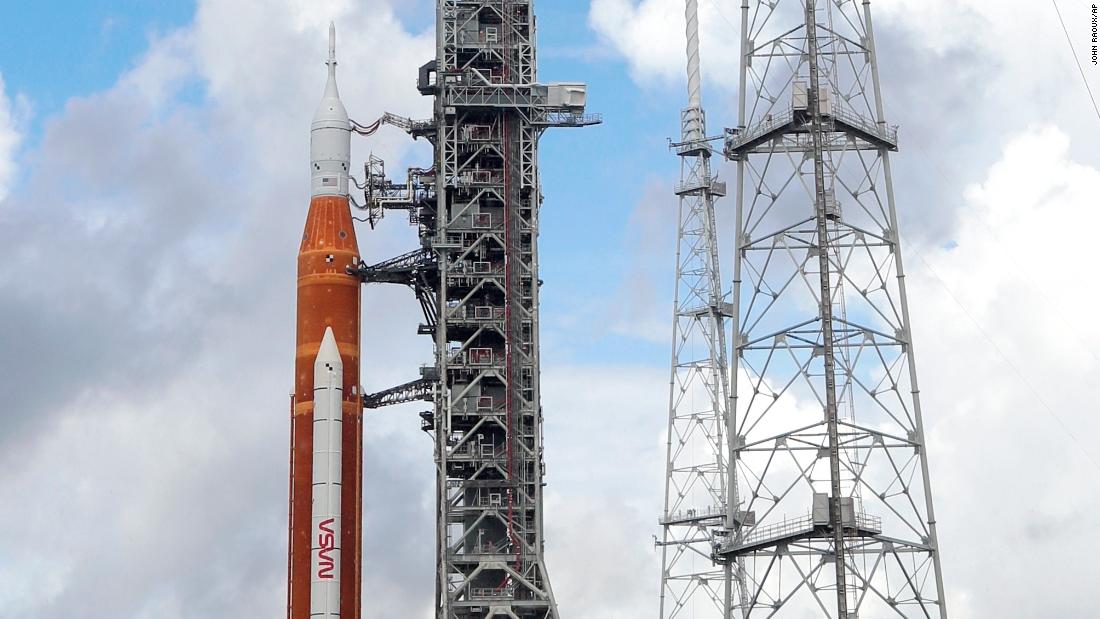Artemis I: Today’s launch scrubbed after engine issue

“Launch controllers were continuing to evaluate why a bleed test to get the RS-25 engines on the bottom of the core stage to the proper temperature range for liftoff was not successful, and ran out of time in the two-hour launch window,” according to an update from NASA. “Engineers are continuing to gather additional data.”
The launch team still needs to troubleshoot the engine issue and will keep the rocket in its current configuration to gather data and assess what needs to be done. Both the Space Launch System rocket and Orion spacecraft, sitting on Launchpad 39B at NASA’s Kennedy Space Center in Florida, remain stable, according to NASA officials.
Prior to the scrub, the countdown was extended into an unplanned hold as the launch team worked on a troubleshooting plan for one of the rocket’s four engines.
That’s because the launch team discovered an issue with an engine bleed in engine #3. Attempts to reconfigure it were unsuccessful.
During engine bleeds, hydrogen is cycled through the engine to condition it for launch. Three of the four engines are performing as expected, but engine #3 experienced an issue.
NASA Administrator Bill Nelson addressed the scrub shortly after it was announced, stressing that Artemis I is a test flight.
“We don’t launch until it’s right,” Nelson said. “They’ve got a problem with the gases going on the engine bleed on one engine. It’s just illustrative that this is a very complicated machine, a very complicated system, and all those things have to work. You don’t light the candle until it’s ready to go.”
It’s something Nelson has personal experience with. As an astronaut, he was on the 24th flight of the Space Shuttle. It was scrubbed four times on the pad and the fifth try resulted in a flawless mission.
“Had we launched on any one of those scrubs, it wouldn’t have been a good day,” he said.
More information will be shared in a news conference in about four hours, according to NASA.
Weather conditions remained 80% favorable for a launch at the beginning of a window that opened at 8:33 a.m. ET. But several issues cropped up after the rocket began fueling after midnight.
Offshore storms with the potential for lightning prevented the team from beginning the fueling process, due to start at midnight, for about an hour.
The hold was lifted at 1:13 a.m. ET, and the tanking process began to load the rocket’s core stage with supercold liquid oxygen and liquid hydrogen.
The team stopped filling the tank with liquid hydrogen twice due to an initial leak as well as a pressure spike, but tanking resumed for the core stage and began for the upper stage, or the interim cryogenic propulsion stage.
The team also discovered a line of frost on the inner stage flange. At first, engineers thought the frost may indicate the presence of a crack in the tank, but it turned out to be a crack in the external foam. The team shared that the issue hds been resolved since the foam crack did not indicate a leak.
Engineers were also working to find out what has caused an 11-minute delay in communications between the Orion spacecraft and ground systems. The issue could have impacted the beginning of terminal count, or the countdown that begins when 10 minutes remain on the clock before liftoff.
Vice President Kamala Harris and Second Gentleman Doug Emhoff were expected to visit Kennedy Space Center Monday to watch the launch.
Appearances by celebrities like Jack Black, Chris Evans and Keke Palmer and performances of “The Star-Spangled Banner” by Josh Groban and Herbie Hancock and “America the Beautiful” by The Philadelphia Orchestra and cellist Yo-Yo Ma were also planned as part of the program.
Mission overview
When Artemis I launches, Orion’s journey will last 42 days as it travels to the moon, loops around it and returns to Earth — traveling a total of 1.3 million miles (2.1 million kilometers). When it returns to Earth, the capsule will splash down in the Pacific Ocean off the coast of San Diego.
While the passenger list doesn’t include any humans, it does have passengers: three mannequins and a plush Snoopy toy will ride in Orion.
Expect to see views of Earthrise, similar to what was shared during Apollo 8 for the first time, but with much better cameras and technology.
The inaugural mission of the Artemis program will kick off a phase of space exploration that lands diverse astronaut crews at previously unexplored regions of the moon and eventually delivers crewed missions to Mars.
Source link





